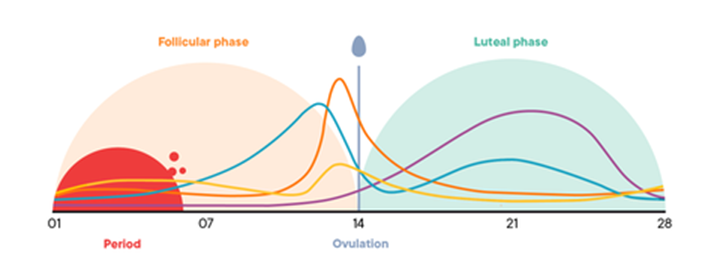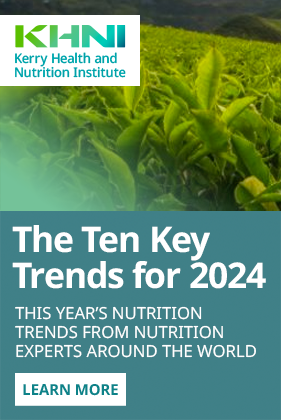With women’s health being an important focus for health and nutrition, one area of women’s health is that is sometimes overlooked is the menstrual cycle. Over the course of the menstrual cycle, those who menstruate have different calorie and nutrient requirements due to fluctuations in hormones. These hormones not only influence your monthly cycle, but also your body temperature, metabolism, hunger and food cravings.
Cycle syncing is a concept that has gained increasing attention in recent years but has been around for centuries. It’s the practice of aligning your lifestyle, nutrition, and self-care routines with the natural fluctuations of your menstrual cycle. Understanding the phases of your cycle and the specific needs associated with each one, can help to better manage your symptoms and optimize your well-being. Our needs evolve over the course of the menstrual cycle, and by being aware of these changes, you can take proactive steps to support your physical and emotional health. Tracking your cycle is the first step for people who are menstruating, to be more informed about their bodies and what is normal for them. Once you are informed about the changes in your body, you can make alterations to support your diet, tailor your exercise to suit your energy levels and make changes to support your mood and sleep.
The menstrual cycle is divided into four phases: menstruation, the follicular phase, ovulation, and the luteal phase. Each phase has unique hormonal changes, physical symptoms, nutrient requirements, and emotional states.
Click through the interactive infographic below to explore the nutritional and physical activity recommendations across the menstrual cycle:
The following information is summarized in the interactive infographic above.
Menstruation / Period (Typically days 1-7):
-
-
- Oestrogen levels will be low
- You may experience fatigue and PMS symptoms, such as cramps.
- Lower Energy
-
Nutrition Focus: Iron deficiency anaemia is very common for those who menstruate, therefore increasing your intake of food sources of iron is important to replenish this iron lost as well as to combat fatigue. Increasing your iron intake is important as iron deficiency anaemia from blood loss is very common for those who menstruate.
Iron-rich foods include both animal (haem iron) sources, eg. liver and red meat, and plant based (non-haem iron) sources eg. leafy greens and legumes. Incorporating magnesium-rich foods, such as nuts and seeds can relieve migraines and mood swings, and incorporating foods rich in omega 3 such as salmon, flax seeds, and avocado, can alleviate cramps.
*Top tip: Prioritize Essential Tasks. Focus on completing essential but less demanding tasks that don’t require intense concentration.
Follicular Phase (Typically days 1-13):
-
-
- Oestrogen levels start to rise
- Energy levels increase and mood improves
- You might feel more social and extroverted.
-
Nutrition Focus: As oestrogen levels increase, choose an overall healthy diet rich in fibre and micronutrients like whole grains, fruits, and vegetables to support hormonal balance and provide sustained energy, and focus on hydration. Include sources of healthy fats such as avocados and fatty fish to enhance mood and cognitive function, and fermented foods such as yoghurt and kimchi for gut health
Exercise: This is a good time of the month to prioritize high intensity and strength training like group fitness classes.
*Top tip: Use this phase to plan and initiate important projects or tasks that require creativity and strategic thinking. Schedule meetings, brainstorming sessions, and collaborative activities during this phase when your energy levels are higher.

Ovulation (Around Day 14):
-
-
- Oestrogen surges, and energy levels are at their peak
- We feel our best, with heightened confidence and energy.
-
Nutrition Focus: Similarly to the follicular phase, during ovulation, focus on an overall healthy diet including nutrient-dense foods like eggs, lean proteins, and leafy greens that provide sustained energy to accommodate the surge in energy in the body. These support the surge in energy. Additionally, hydration is crucial as the body’s temperature rises.
Exercise: This is the best time for high intensity and strength focused exercise like bootcamp and kickboxing, as you reach peak energy due to a rise in testosterone.
*Top tip: Tackle high-impact tasks, presentations, or negotiations when you’re at your most sociable and persuasive. Attend corporate events, conferences, or networking functions to build relationships and expand your professional network.
Luteal Phase (Typically days 15-28):
-
-
- Oestrogen drops and progesterone increases, which can affect digestion and appetite causing cravings.
- Breast tenderness, bloating, and mood swings.
- Energy levels can dip and we can feel more introverted
- Sleep disruption can be common which can affect irritability and performance.
-
Nutrition Focus: Make sure you are getting enough protein and healthy fats to sustain you during this phase to avoid reaching for high energy foods. Prioritize complex carbohydrates and foods high in fibre like whole grains and sweet potatoes to stabilize blood sugar levels and support mood and energy levels. Incorporate foods rich in vitamin B6 and magnesium, such as bananas and chickpeas, to help alleviate PMS symptoms such as bloating, and support emotional balance. Increasing foods high in vitamin D and calcium can also benefit to reduce PMS symptoms.
Exercise Focus: Medium to light exercise and active recovery like yoga and walking are best for this time of the month.
*Top tip: Concentrate on detail-oriented tasks such as data analysis, report writing, and quality control. Use time management techniques to stay organized and efficient, as mood swings and PMS symptoms can be more pronounced during this phase.
Your needs can significantly shift over the course of the menstrual cycle, and being attuned to these changes can be a game-changer in managing various symptoms. By recognizing the change of hormones and their effects on physical and emotional well-being during different phases of the cycle, we can implement strategies to feel happier and healthier. Whether it’s adjusting dietary choices, exercise routines, or self-care practices, these small changes can have a huge positive impact. By practicing cycle syncing methods, we can have a deeper sense of well-being and harmony throughout the entire menstrual cycle.
This article was co-authored by experts from KHNI and Riley, an award-winning Irish, female founded period care brand.
-
Beth Hughes, BSc, ANutr
 Beth works as a Project Manager for Diversity, Inclusion & Belonging in Europe at Kerry, her role involves supporting Europe towards its gender targets in line with Kerry’s Beyond the Horizon Strategy. Beth also is the “Enhance” pillar lead of the Women@Kerry employee network group in Europe which supports the period positive roll out and the quarterly networking series. She is passionate about wellness, sustainable nutrition, and women’s health research. Beth is a graduate of University College Dublin with a BSc in Human Nutrition and is a Registered Associate Nutritionist (ANutr) with the Association for Nutrition (UKVRN).
Beth works as a Project Manager for Diversity, Inclusion & Belonging in Europe at Kerry, her role involves supporting Europe towards its gender targets in line with Kerry’s Beyond the Horizon Strategy. Beth also is the “Enhance” pillar lead of the Women@Kerry employee network group in Europe which supports the period positive roll out and the quarterly networking series. She is passionate about wellness, sustainable nutrition, and women’s health research. Beth is a graduate of University College Dublin with a BSc in Human Nutrition and is a Registered Associate Nutritionist (ANutr) with the Association for Nutrition (UKVRN). -
Kate Bourke
 This article was co-authored by Kate Bourke, Content & Community Manager for Riley.
This article was co-authored by Kate Bourke, Content & Community Manager for Riley.Sustainable Period Care Brand – Our Story | Riley (weareriley.com)
Riley is an Award-winning, Irish, female founded period care brand. We provide 100% certified organic cotton, eco- friendly period products, that are free from toxins and harmful chemicals. There are zero pesticides and zero chlorine bleach.
One of our biggest missions is our fight against period poverty. We donate 1% of every sale to fighting period poverty which unfortunately is still a huge issue around the world today. We have donated 50,000 period products and educated 3,000 Kenyan students on the importance of menstrual health.
-
Alison McNamara
 Alison McNamara had been a KHNI Sustainability Summer 2023 Intern. She currently attends Trinity College Dublin where she studies Geography and Sociology Joint Honours. She is in her final year of study where she is completing her dissertation on ‘Urban Sustainable Food Consumption’.
Alison McNamara had been a KHNI Sustainability Summer 2023 Intern. She currently attends Trinity College Dublin where she studies Geography and Sociology Joint Honours. She is in her final year of study where she is completing her dissertation on ‘Urban Sustainable Food Consumption’. -
References
General:
- Premenstrual disorders: prevalence, etiology and impact – PubMed (nih.gov) Winer SA, Rapkin AJ. Premenstrual disorders: prevalence, etiology and impact. J Reprod Med. 2006 Apr;51(4 Suppl):339-47. PMID: 16734317.
- The impact of menstrual symptoms on everyday life: a survey among 42,879 women – PubMed (nih.gov) Schoep ME, Nieboer TE, van der Zanden M, Braat DDM, Nap AW. The impact of menstrual symptoms on everyday life: a survey among 42,879 women. Am J Obstet Gynecol. 2019 Jun;220(6):569.e1-569.e7. doi: 10.1016/j.ajog.2019.02.048. Epub 2019 Mar 15. PMID: 30885768.
- Mood and the menstrual cycle: a review of prospective data studies – PubMed (nih.gov) Romans S, Clarkson R, Einstein G, Petrovic M, Stewart D. Mood and the menstrual cycle: a review of prospective data studies. Gend Med. 2012 Oct;9(5):361-84. doi: 10.1016/j.genm.2012.07.003. PMID: 23036262.
Sleep:
- Menstrual Cycle Effects on Sleep – PubMed (nih.gov) Baker FC, Lee KA. Menstrual Cycle Effects on Sleep. Sleep Med Clin. 2022 Jun;17(2):283-294. doi: 10.1016/j.jsmc.2022.02.004. Epub 2022 Apr 22. PMID: 35659080.
Nutrition:
- Nutritional practices to manage menstrual cycle related symptoms: a systematic review – PubMed (nih.gov) Brown N, Martin D, Waldron M, Bruinvels G, Farrant L, Fairchild R. Nutritional practices to manage menstrual cycle related symptoms: a systematic review. Nutr Res Rev. 2023 Sep 25:1-24. doi: 10.1017/S0954422423000227. Epub ahead of print. PMID: 37746736.
- Global, regional, and national trends in haemoglobin concentration and prevalence of total and severe anaemia in children and pregnant and non-pregnant women for 1995–2011: a systematic analysis of population-representative data – PMC (nih.gov) Stevens GA, Finucane MM, De-Regil LM, Paciorek CJ, Flaxman SR, Branca F, Peña-Rosas JP, Bhutta ZA, Ezzati M; Nutrition Impact Model Study Group (Anaemia). Global, regional, and national trends in haemoglobin concentration and prevalence of total and severe anaemia in children and pregnant and non-pregnant women for 1995-2011: a systematic analysis of population-representative data. Lancet Glob Health. 2013 Jul;1(1):e16-25. doi: 10.1016/S2214-109X(13)70001-9. Epub 2013 Jun 25. PMID: 25103581; PMCID: PMC4547326.
- Carbohydrate and fiber intake and the risk of premenstrual syndrome – PMC (nih.gov) Houghton SC, Manson JE, Whitcomb BW, Hankinson SE, Troy LM, Bigelow C, Bertone-Johnson ER. Carbohydrate and fiber intake and the risk of premenstrual syndrome. Eur J Clin Nutr. 2018 Jun;72(6):861-870. doi: 10.1038/s41430-017-0076-8. Epub 2018 Jan 29. PMID: 29379144; PMCID: PMC5990431.
- Intake of selected minerals and risk of premenstrual syndrome – PubMed (nih.gov) Chocano-Bedoya PO, Manson JE, Hankinson SE, Johnson SR, Chasan-Taber L, Ronnenberg AG, Bigelow C, Bertone-Johnson ER. Intake of selected minerals and risk of premenstrual syndrome. Am J Epidemiol. 2013 May 15;177(10):1118-27. doi: 10.1093/aje/kws363. Epub 2013 Feb 26. PMID: 23444100; PMCID: PMC3649635.
- A systematic review of the role of vitamin D and calcium in premenstrual syndrome – PubMed (nih.gov) Abdi F, Ozgoli G, Rahnemaie FS. A systematic review of the role of vitamin D and calcium in premenstrual syndrome. Obstet Gynecol Sci. 2019 Mar;62(2):73-86. doi: 10.5468/ogs.2019.62.2.73. Epub 2019 Feb 25. Erratum in: Obstet Gynecol Sci. 2020 Mar;63(2):213. PMID: 30918875; PMCID: PMC6422848.
- Efficacy of vitamin B-6 in the treatment of premenstrual syndrome: systematic review – PubMed (nih.gov) Wyatt KM, Dimmock PW, Jones PW, Shaughn O’Brien PM. Efficacy of vitamin B-6 in the treatment of premenstrual syndrome: systematic review. BMJ. 1999 May 22;318(7195):1375-81. doi: 10.1136/bmj.318.7195.1375. PMID: 10334745; PMCID: PMC27878.
- Dietary Reference Values for nutrients Summary report | EFSA (europa.eu)
Exercise:
- The Effects of Menstrual Cycle Phase on Exercise Performance in Eumenorrheic Women: A Systematic Review and Meta-Analysis – PubMed (nih.gov) McNulty KL, Elliott-Sale KJ, Dolan E, Swinton PA, Ansdell P, Goodall S, Thomas K, Hicks KM. The Effects of Menstrual Cycle Phase on Exercise Performance in Eumenorrheic Women: A Systematic Review and Meta-Analysis. Sports Med. 2020 Oct;50(10):1813-1827. doi: 10.1007/s40279-020-01319-3. PMID: 32661839; PMCID: PMC7497427.
- Anaerobic power performance and the menstrual cycle: eumenorrheic and oral contraceptive users – PubMed (nih.gov) Bushman B, Masterson G, Nelsen J. Anaerobic power performance and the menstrual cycle: eumenorrheic and oral contraceptive users. J Sports Med Phys Fitness. 2006 Mar;46(1):132-7. PMID: 16596112.
- High prevalence of subtle and severe menstrual disturbances in exercising women: confirmation using daily hormone measures – PubMed (nih.gov) De Souza MJ, Toombs RJ, Scheid JL, O’Donnell E, West SL, Williams NI. High prevalence of subtle and severe menstrual disturbances in exercising women: confirmation using daily hormone measures. Hum Reprod. 2010 Feb;25(2):491-503. doi: 10.1093/humrep/dep411. Epub 2009 Nov 26. PMID: 19945961.



